NUR 502: Cultural Competence in Nursing Care and Communication
VerifiedAdded on 2023/06/13
|9
|2054
|334
Report
AI Summary
This report addresses the critical need for culturally competent care and communication in nursing, particularly when serving culturally diverse populations such as Asian American breast cancer patients. It examines an article that highlights communication barriers and cultural insensitivity experienced by these patients, emphasizing the impact of language proficiency and differing cultural understandings of healthcare. The report discusses practical strategies for improving care, including the use of language experts, culturally appropriate patient education, and the implementation of cultural liaison officers. It underscores the importance of cultural sensitivity education for healthcare providers to ensure patient safety and address the unique expectations of ethnic minorities. Ultimately, the report advocates for healthcare as a fundamental right and stresses the need to overcome barriers to deliver patient-centered care for all.

Running head: CULTURALLY COMPETENT CARE AND COMMUNICATION
Culturally competent care and communication
Name of the student:
Name of the university:
Author note:
Culturally competent care and communication
Name of the student:
Name of the university:
Author note:
Paraphrase This Document
Need a fresh take? Get an instant paraphrase of this document with our AI Paraphraser

1
CULTURALLY COMPETENT CARE AND COMMUNICATION
Table of Contents
Introduction:....................................................................................................................................2
Reason for selecting the cultural group:..........................................................................................2
Key points of the article:..................................................................................................................3
Application into the practical scenario:...........................................................................................4
Conclusion:......................................................................................................................................6
References:......................................................................................................................................7
CULTURALLY COMPETENT CARE AND COMMUNICATION
Table of Contents
Introduction:....................................................................................................................................2
Reason for selecting the cultural group:..........................................................................................2
Key points of the article:..................................................................................................................3
Application into the practical scenario:...........................................................................................4
Conclusion:......................................................................................................................................6
References:......................................................................................................................................7
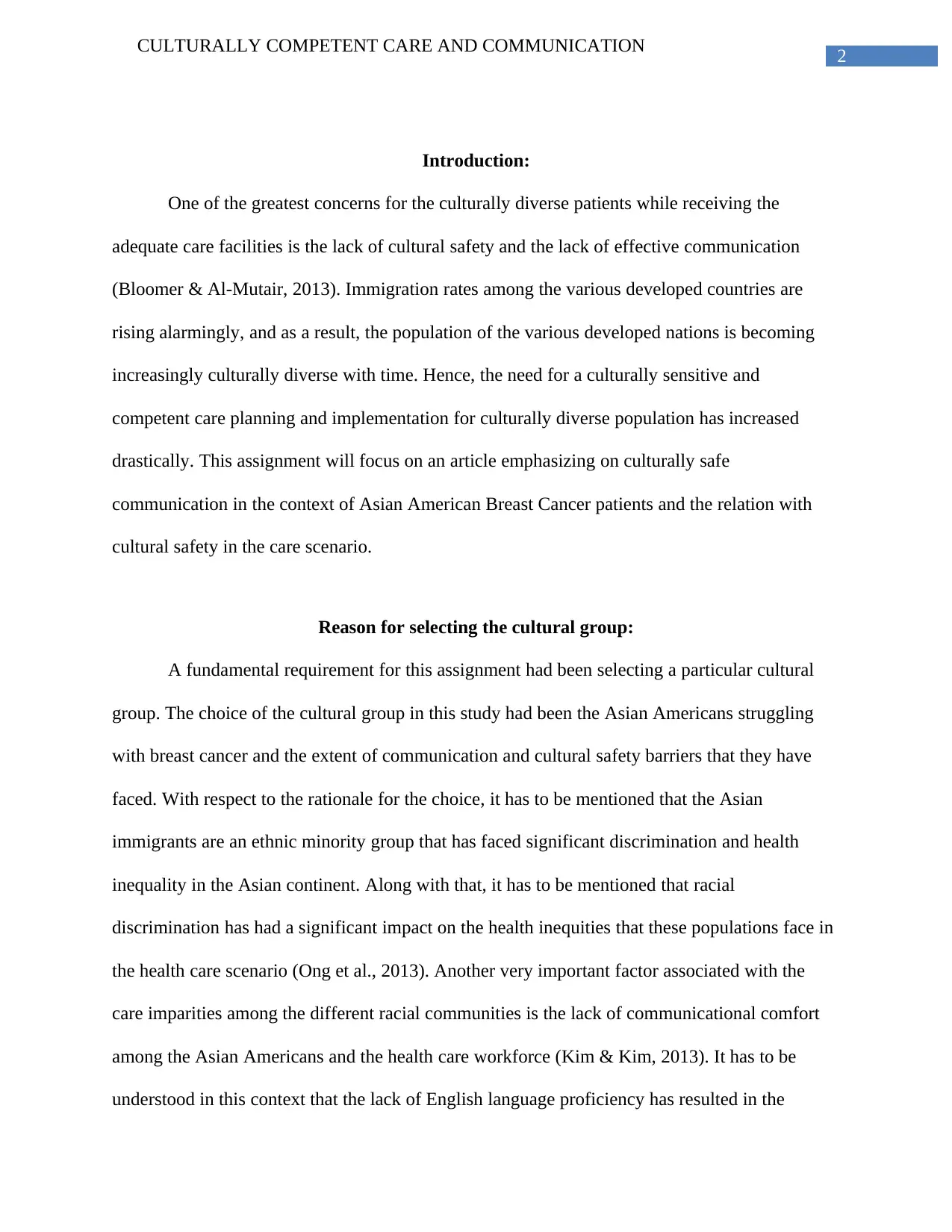
2
CULTURALLY COMPETENT CARE AND COMMUNICATION
Introduction:
One of the greatest concerns for the culturally diverse patients while receiving the
adequate care facilities is the lack of cultural safety and the lack of effective communication
(Bloomer & Al-Mutair, 2013). Immigration rates among the various developed countries are
rising alarmingly, and as a result, the population of the various developed nations is becoming
increasingly culturally diverse with time. Hence, the need for a culturally sensitive and
competent care planning and implementation for culturally diverse population has increased
drastically. This assignment will focus on an article emphasizing on culturally safe
communication in the context of Asian American Breast Cancer patients and the relation with
cultural safety in the care scenario.
Reason for selecting the cultural group:
A fundamental requirement for this assignment had been selecting a particular cultural
group. The choice of the cultural group in this study had been the Asian Americans struggling
with breast cancer and the extent of communication and cultural safety barriers that they have
faced. With respect to the rationale for the choice, it has to be mentioned that the Asian
immigrants are an ethnic minority group that has faced significant discrimination and health
inequality in the Asian continent. Along with that, it has to be mentioned that racial
discrimination has had a significant impact on the health inequities that these populations face in
the health care scenario (Ong et al., 2013). Another very important factor associated with the
care imparities among the different racial communities is the lack of communicational comfort
among the Asian Americans and the health care workforce (Kim & Kim, 2013). It has to be
understood in this context that the lack of English language proficiency has resulted in the
CULTURALLY COMPETENT CARE AND COMMUNICATION
Introduction:
One of the greatest concerns for the culturally diverse patients while receiving the
adequate care facilities is the lack of cultural safety and the lack of effective communication
(Bloomer & Al-Mutair, 2013). Immigration rates among the various developed countries are
rising alarmingly, and as a result, the population of the various developed nations is becoming
increasingly culturally diverse with time. Hence, the need for a culturally sensitive and
competent care planning and implementation for culturally diverse population has increased
drastically. This assignment will focus on an article emphasizing on culturally safe
communication in the context of Asian American Breast Cancer patients and the relation with
cultural safety in the care scenario.
Reason for selecting the cultural group:
A fundamental requirement for this assignment had been selecting a particular cultural
group. The choice of the cultural group in this study had been the Asian Americans struggling
with breast cancer and the extent of communication and cultural safety barriers that they have
faced. With respect to the rationale for the choice, it has to be mentioned that the Asian
immigrants are an ethnic minority group that has faced significant discrimination and health
inequality in the Asian continent. Along with that, it has to be mentioned that racial
discrimination has had a significant impact on the health inequities that these populations face in
the health care scenario (Ong et al., 2013). Another very important factor associated with the
care imparities among the different racial communities is the lack of communicational comfort
among the Asian Americans and the health care workforce (Kim & Kim, 2013). It has to be
understood in this context that the lack of English language proficiency has resulted in the
⊘ This is a preview!⊘
Do you want full access?
Subscribe today to unlock all pages.

Trusted by 1+ million students worldwide
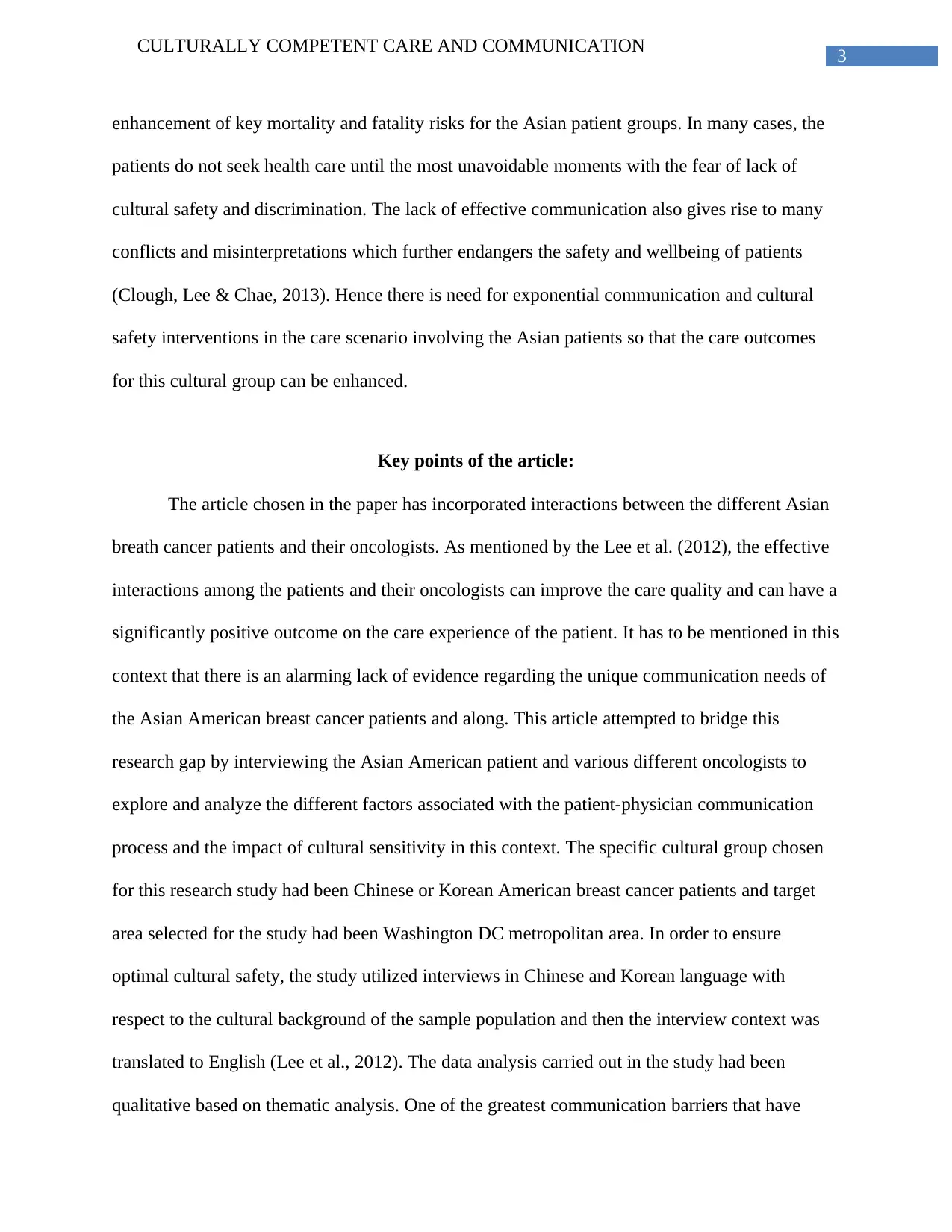
3
CULTURALLY COMPETENT CARE AND COMMUNICATION
enhancement of key mortality and fatality risks for the Asian patient groups. In many cases, the
patients do not seek health care until the most unavoidable moments with the fear of lack of
cultural safety and discrimination. The lack of effective communication also gives rise to many
conflicts and misinterpretations which further endangers the safety and wellbeing of patients
(Clough, Lee & Chae, 2013). Hence there is need for exponential communication and cultural
safety interventions in the care scenario involving the Asian patients so that the care outcomes
for this cultural group can be enhanced.
Key points of the article:
The article chosen in the paper has incorporated interactions between the different Asian
breath cancer patients and their oncologists. As mentioned by the Lee et al. (2012), the effective
interactions among the patients and their oncologists can improve the care quality and can have a
significantly positive outcome on the care experience of the patient. It has to be mentioned in this
context that there is an alarming lack of evidence regarding the unique communication needs of
the Asian American breast cancer patients and along. This article attempted to bridge this
research gap by interviewing the Asian American patient and various different oncologists to
explore and analyze the different factors associated with the patient-physician communication
process and the impact of cultural sensitivity in this context. The specific cultural group chosen
for this research study had been Chinese or Korean American breast cancer patients and target
area selected for the study had been Washington DC metropolitan area. In order to ensure
optimal cultural safety, the study utilized interviews in Chinese and Korean language with
respect to the cultural background of the sample population and then the interview context was
translated to English (Lee et al., 2012). The data analysis carried out in the study had been
qualitative based on thematic analysis. One of the greatest communication barriers that have
CULTURALLY COMPETENT CARE AND COMMUNICATION
enhancement of key mortality and fatality risks for the Asian patient groups. In many cases, the
patients do not seek health care until the most unavoidable moments with the fear of lack of
cultural safety and discrimination. The lack of effective communication also gives rise to many
conflicts and misinterpretations which further endangers the safety and wellbeing of patients
(Clough, Lee & Chae, 2013). Hence there is need for exponential communication and cultural
safety interventions in the care scenario involving the Asian patients so that the care outcomes
for this cultural group can be enhanced.
Key points of the article:
The article chosen in the paper has incorporated interactions between the different Asian
breath cancer patients and their oncologists. As mentioned by the Lee et al. (2012), the effective
interactions among the patients and their oncologists can improve the care quality and can have a
significantly positive outcome on the care experience of the patient. It has to be mentioned in this
context that there is an alarming lack of evidence regarding the unique communication needs of
the Asian American breast cancer patients and along. This article attempted to bridge this
research gap by interviewing the Asian American patient and various different oncologists to
explore and analyze the different factors associated with the patient-physician communication
process and the impact of cultural sensitivity in this context. The specific cultural group chosen
for this research study had been Chinese or Korean American breast cancer patients and target
area selected for the study had been Washington DC metropolitan area. In order to ensure
optimal cultural safety, the study utilized interviews in Chinese and Korean language with
respect to the cultural background of the sample population and then the interview context was
translated to English (Lee et al., 2012). The data analysis carried out in the study had been
qualitative based on thematic analysis. One of the greatest communication barriers that have
Paraphrase This Document
Need a fresh take? Get an instant paraphrase of this document with our AI Paraphraser
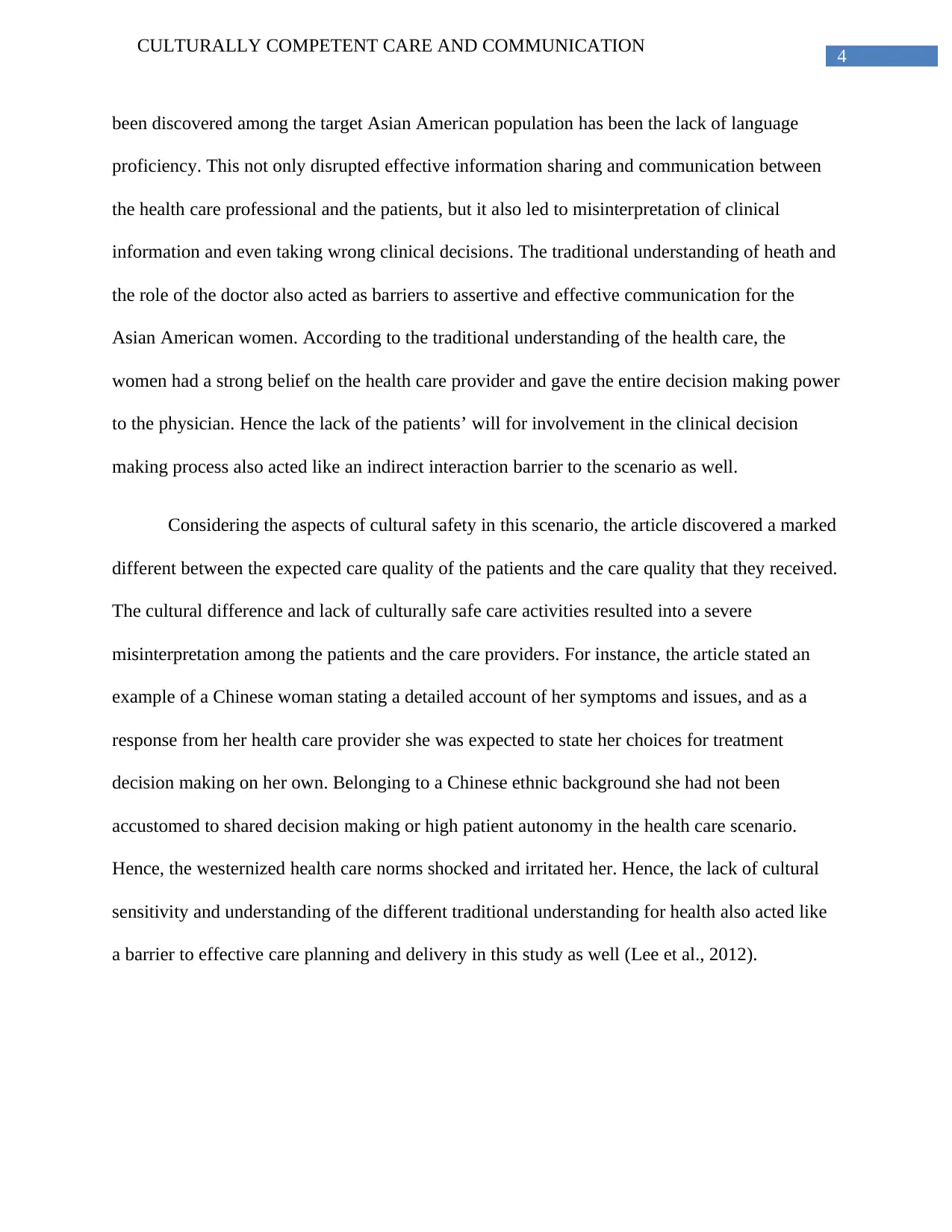
4
CULTURALLY COMPETENT CARE AND COMMUNICATION
been discovered among the target Asian American population has been the lack of language
proficiency. This not only disrupted effective information sharing and communication between
the health care professional and the patients, but it also led to misinterpretation of clinical
information and even taking wrong clinical decisions. The traditional understanding of heath and
the role of the doctor also acted as barriers to assertive and effective communication for the
Asian American women. According to the traditional understanding of the health care, the
women had a strong belief on the health care provider and gave the entire decision making power
to the physician. Hence the lack of the patients’ will for involvement in the clinical decision
making process also acted like an indirect interaction barrier to the scenario as well.
Considering the aspects of cultural safety in this scenario, the article discovered a marked
different between the expected care quality of the patients and the care quality that they received.
The cultural difference and lack of culturally safe care activities resulted into a severe
misinterpretation among the patients and the care providers. For instance, the article stated an
example of a Chinese woman stating a detailed account of her symptoms and issues, and as a
response from her health care provider she was expected to state her choices for treatment
decision making on her own. Belonging to a Chinese ethnic background she had not been
accustomed to shared decision making or high patient autonomy in the health care scenario.
Hence, the westernized health care norms shocked and irritated her. Hence, the lack of cultural
sensitivity and understanding of the different traditional understanding for health also acted like
a barrier to effective care planning and delivery in this study as well (Lee et al., 2012).
CULTURALLY COMPETENT CARE AND COMMUNICATION
been discovered among the target Asian American population has been the lack of language
proficiency. This not only disrupted effective information sharing and communication between
the health care professional and the patients, but it also led to misinterpretation of clinical
information and even taking wrong clinical decisions. The traditional understanding of heath and
the role of the doctor also acted as barriers to assertive and effective communication for the
Asian American women. According to the traditional understanding of the health care, the
women had a strong belief on the health care provider and gave the entire decision making power
to the physician. Hence the lack of the patients’ will for involvement in the clinical decision
making process also acted like an indirect interaction barrier to the scenario as well.
Considering the aspects of cultural safety in this scenario, the article discovered a marked
different between the expected care quality of the patients and the care quality that they received.
The cultural difference and lack of culturally safe care activities resulted into a severe
misinterpretation among the patients and the care providers. For instance, the article stated an
example of a Chinese woman stating a detailed account of her symptoms and issues, and as a
response from her health care provider she was expected to state her choices for treatment
decision making on her own. Belonging to a Chinese ethnic background she had not been
accustomed to shared decision making or high patient autonomy in the health care scenario.
Hence, the westernized health care norms shocked and irritated her. Hence, the lack of cultural
sensitivity and understanding of the different traditional understanding for health also acted like
a barrier to effective care planning and delivery in this study as well (Lee et al., 2012).

5
CULTURALLY COMPETENT CARE AND COMMUNICATION
Application into the practical scenario:
This article has discovered 2 key themes regarding the lack of proper care delivery to the
Asian American patients, one being the lack of effective communication and the second being
the lack of cultural sensitivity in the care scenario. As explored by the article it has to be
mentioned that the language proficiency among the Asian American women was discovered as
the most impactful barrier to effective communication (Lee et al., 2012). The introduction of
language experts and translators has proved to be a very important tool for effective
communication among culturally diverse patients and care providers (Mareno & Hart, 2014).
Hence that is the first recommendation that can be applied in the practical scenario, when
involving any specific cultural group, the utilization of language experts and translators will be
beneficial for both the culturally diverse patients to understand the specific instruction and
recommendations and for the health care providers to be able to understand the specific choices
and grievances faced by the patient. The implementation of linguistically appropriate and
culturally competent patient education program for culturally diverse patient groups to teach
strategies and skills for communicating effectively with the care providers can also be beneficial
in practical scenario (Renzaho et al., 2013).
The second recommendation that can be applied to the practice situation involving the
culturally diverse patient groups is the implementation of cultural liaison officer that will provide
insight regarding the traditional understanding for health and will help the care professionals
discover and understand the expectation of Asian ethnic patient groups (Shen, 2015). Lastly the
article by Lee et al. (2012) suggested that for the Asian patient population, acknowledging the
patient preferences regarding the level of patient involvement in decision making varied from the
rest of the main stream societies. Hence, there is need for a cultural sensitivity education
CULTURALLY COMPETENT CARE AND COMMUNICATION
Application into the practical scenario:
This article has discovered 2 key themes regarding the lack of proper care delivery to the
Asian American patients, one being the lack of effective communication and the second being
the lack of cultural sensitivity in the care scenario. As explored by the article it has to be
mentioned that the language proficiency among the Asian American women was discovered as
the most impactful barrier to effective communication (Lee et al., 2012). The introduction of
language experts and translators has proved to be a very important tool for effective
communication among culturally diverse patients and care providers (Mareno & Hart, 2014).
Hence that is the first recommendation that can be applied in the practical scenario, when
involving any specific cultural group, the utilization of language experts and translators will be
beneficial for both the culturally diverse patients to understand the specific instruction and
recommendations and for the health care providers to be able to understand the specific choices
and grievances faced by the patient. The implementation of linguistically appropriate and
culturally competent patient education program for culturally diverse patient groups to teach
strategies and skills for communicating effectively with the care providers can also be beneficial
in practical scenario (Renzaho et al., 2013).
The second recommendation that can be applied to the practice situation involving the
culturally diverse patient groups is the implementation of cultural liaison officer that will provide
insight regarding the traditional understanding for health and will help the care professionals
discover and understand the expectation of Asian ethnic patient groups (Shen, 2015). Lastly the
article by Lee et al. (2012) suggested that for the Asian patient population, acknowledging the
patient preferences regarding the level of patient involvement in decision making varied from the
rest of the main stream societies. Hence, there is need for a cultural sensitivity education
⊘ This is a preview!⊘
Do you want full access?
Subscribe today to unlock all pages.

Trusted by 1+ million students worldwide
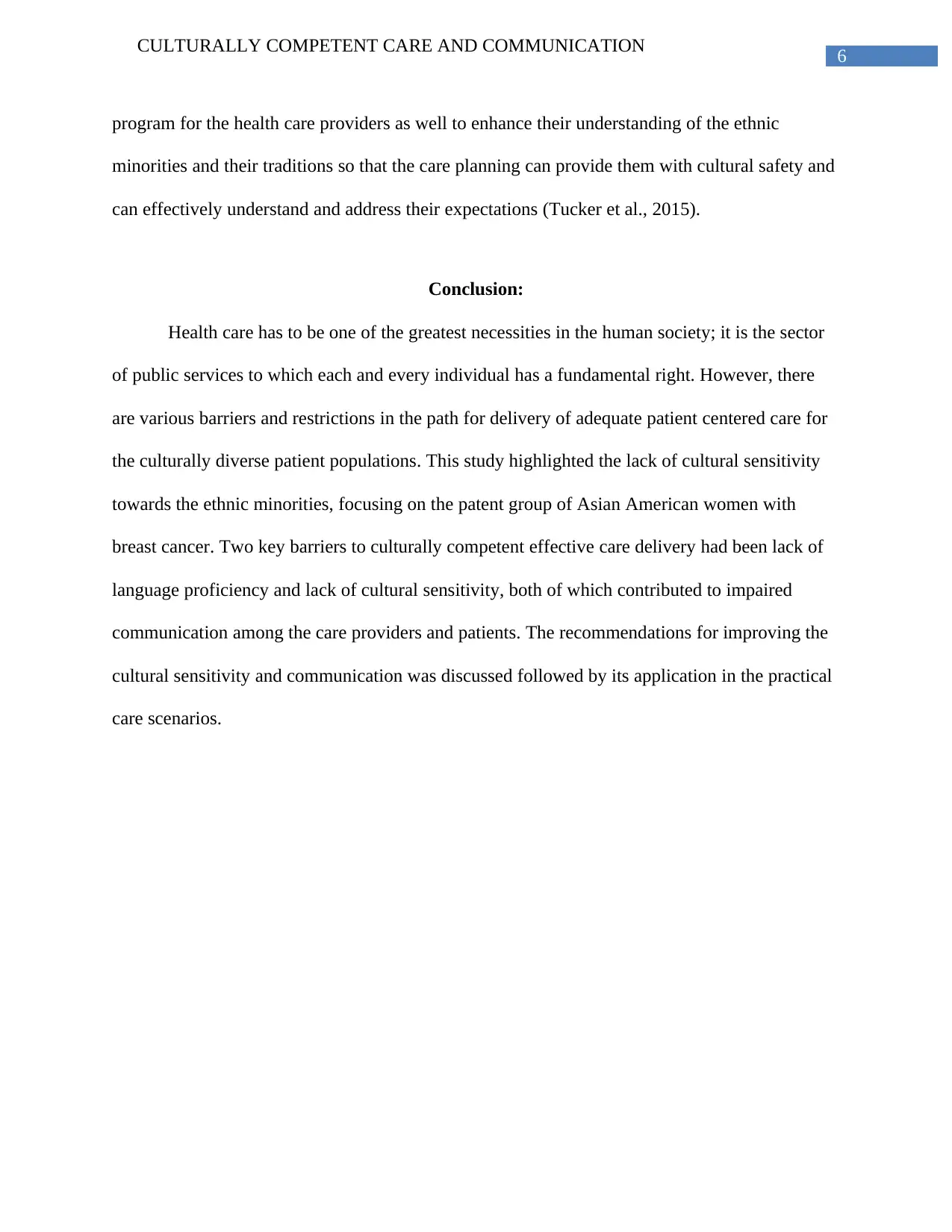
6
CULTURALLY COMPETENT CARE AND COMMUNICATION
program for the health care providers as well to enhance their understanding of the ethnic
minorities and their traditions so that the care planning can provide them with cultural safety and
can effectively understand and address their expectations (Tucker et al., 2015).
Conclusion:
Health care has to be one of the greatest necessities in the human society; it is the sector
of public services to which each and every individual has a fundamental right. However, there
are various barriers and restrictions in the path for delivery of adequate patient centered care for
the culturally diverse patient populations. This study highlighted the lack of cultural sensitivity
towards the ethnic minorities, focusing on the patent group of Asian American women with
breast cancer. Two key barriers to culturally competent effective care delivery had been lack of
language proficiency and lack of cultural sensitivity, both of which contributed to impaired
communication among the care providers and patients. The recommendations for improving the
cultural sensitivity and communication was discussed followed by its application in the practical
care scenarios.
CULTURALLY COMPETENT CARE AND COMMUNICATION
program for the health care providers as well to enhance their understanding of the ethnic
minorities and their traditions so that the care planning can provide them with cultural safety and
can effectively understand and address their expectations (Tucker et al., 2015).
Conclusion:
Health care has to be one of the greatest necessities in the human society; it is the sector
of public services to which each and every individual has a fundamental right. However, there
are various barriers and restrictions in the path for delivery of adequate patient centered care for
the culturally diverse patient populations. This study highlighted the lack of cultural sensitivity
towards the ethnic minorities, focusing on the patent group of Asian American women with
breast cancer. Two key barriers to culturally competent effective care delivery had been lack of
language proficiency and lack of cultural sensitivity, both of which contributed to impaired
communication among the care providers and patients. The recommendations for improving the
cultural sensitivity and communication was discussed followed by its application in the practical
care scenarios.
Paraphrase This Document
Need a fresh take? Get an instant paraphrase of this document with our AI Paraphraser
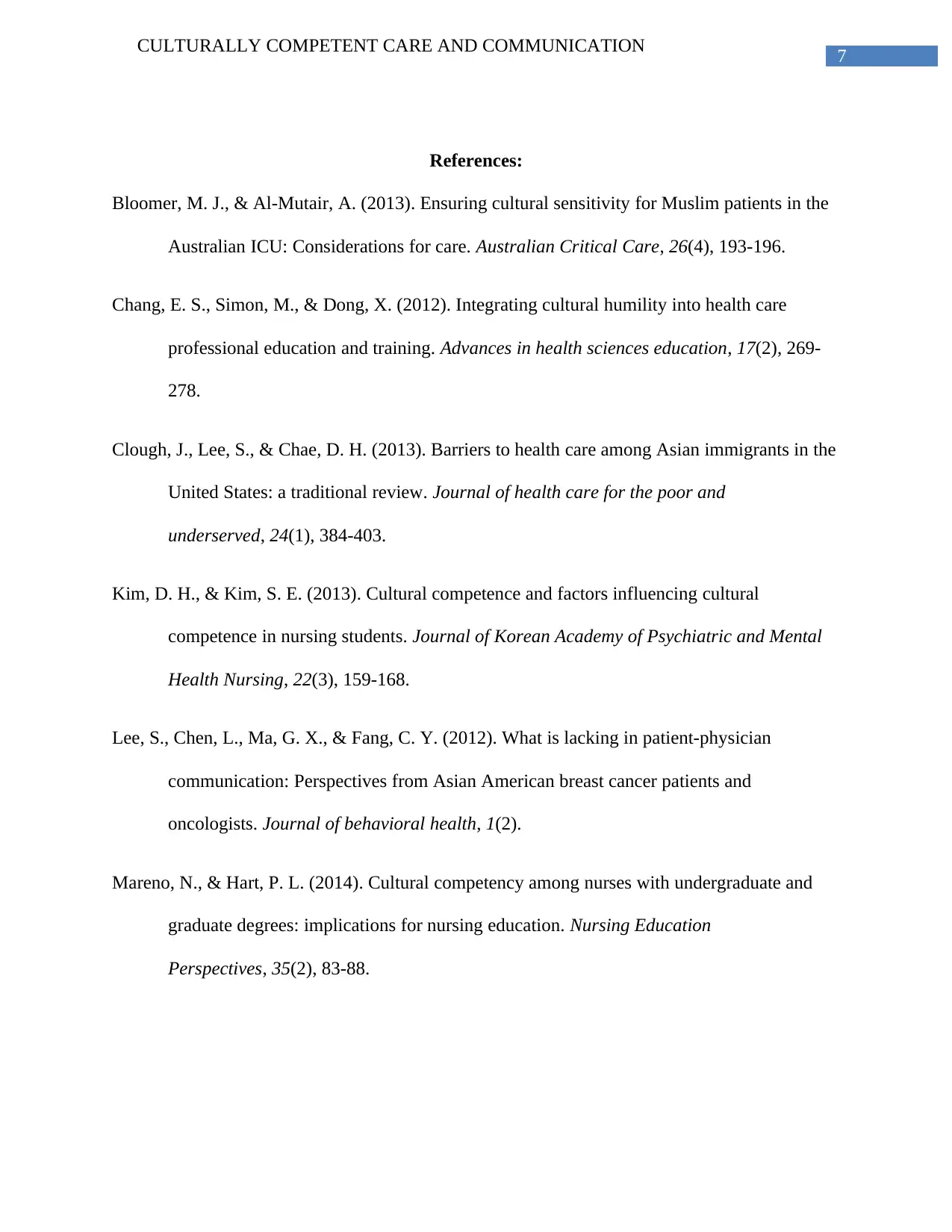
7
CULTURALLY COMPETENT CARE AND COMMUNICATION
References:
Bloomer, M. J., & Al-Mutair, A. (2013). Ensuring cultural sensitivity for Muslim patients in the
Australian ICU: Considerations for care. Australian Critical Care, 26(4), 193-196.
Chang, E. S., Simon, M., & Dong, X. (2012). Integrating cultural humility into health care
professional education and training. Advances in health sciences education, 17(2), 269-
278.
Clough, J., Lee, S., & Chae, D. H. (2013). Barriers to health care among Asian immigrants in the
United States: a traditional review. Journal of health care for the poor and
underserved, 24(1), 384-403.
Kim, D. H., & Kim, S. E. (2013). Cultural competence and factors influencing cultural
competence in nursing students. Journal of Korean Academy of Psychiatric and Mental
Health Nursing, 22(3), 159-168.
Lee, S., Chen, L., Ma, G. X., & Fang, C. Y. (2012). What is lacking in patient-physician
communication: Perspectives from Asian American breast cancer patients and
oncologists. Journal of behavioral health, 1(2).
Mareno, N., & Hart, P. L. (2014). Cultural competency among nurses with undergraduate and
graduate degrees: implications for nursing education. Nursing Education
Perspectives, 35(2), 83-88.
CULTURALLY COMPETENT CARE AND COMMUNICATION
References:
Bloomer, M. J., & Al-Mutair, A. (2013). Ensuring cultural sensitivity for Muslim patients in the
Australian ICU: Considerations for care. Australian Critical Care, 26(4), 193-196.
Chang, E. S., Simon, M., & Dong, X. (2012). Integrating cultural humility into health care
professional education and training. Advances in health sciences education, 17(2), 269-
278.
Clough, J., Lee, S., & Chae, D. H. (2013). Barriers to health care among Asian immigrants in the
United States: a traditional review. Journal of health care for the poor and
underserved, 24(1), 384-403.
Kim, D. H., & Kim, S. E. (2013). Cultural competence and factors influencing cultural
competence in nursing students. Journal of Korean Academy of Psychiatric and Mental
Health Nursing, 22(3), 159-168.
Lee, S., Chen, L., Ma, G. X., & Fang, C. Y. (2012). What is lacking in patient-physician
communication: Perspectives from Asian American breast cancer patients and
oncologists. Journal of behavioral health, 1(2).
Mareno, N., & Hart, P. L. (2014). Cultural competency among nurses with undergraduate and
graduate degrees: implications for nursing education. Nursing Education
Perspectives, 35(2), 83-88.
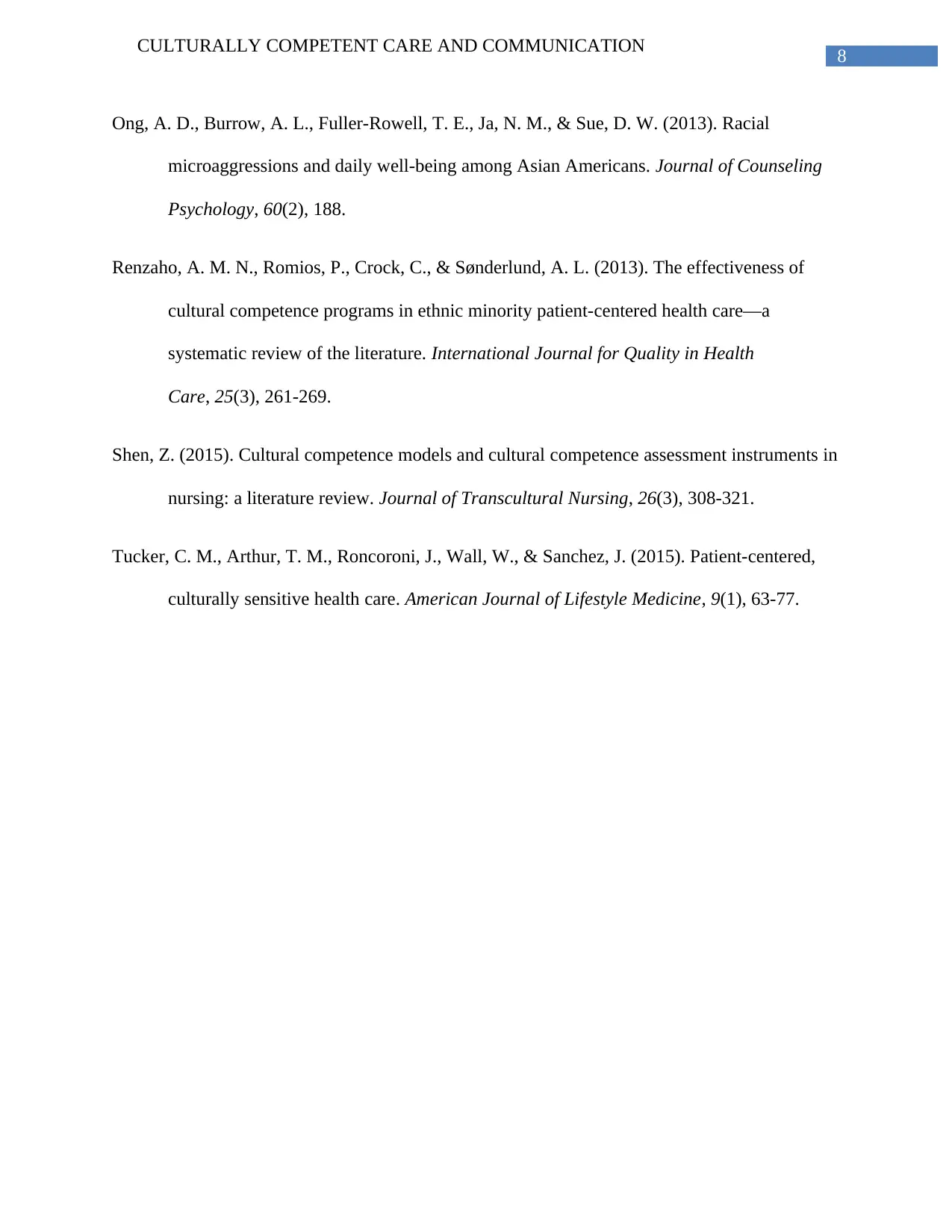
8
CULTURALLY COMPETENT CARE AND COMMUNICATION
Ong, A. D., Burrow, A. L., Fuller-Rowell, T. E., Ja, N. M., & Sue, D. W. (2013). Racial
microaggressions and daily well-being among Asian Americans. Journal of Counseling
Psychology, 60(2), 188.
Renzaho, A. M. N., Romios, P., Crock, C., & Sønderlund, A. L. (2013). The effectiveness of
cultural competence programs in ethnic minority patient-centered health care—a
systematic review of the literature. International Journal for Quality in Health
Care, 25(3), 261-269.
Shen, Z. (2015). Cultural competence models and cultural competence assessment instruments in
nursing: a literature review. Journal of Transcultural Nursing, 26(3), 308-321.
Tucker, C. M., Arthur, T. M., Roncoroni, J., Wall, W., & Sanchez, J. (2015). Patient-centered,
culturally sensitive health care. American Journal of Lifestyle Medicine, 9(1), 63-77.
CULTURALLY COMPETENT CARE AND COMMUNICATION
Ong, A. D., Burrow, A. L., Fuller-Rowell, T. E., Ja, N. M., & Sue, D. W. (2013). Racial
microaggressions and daily well-being among Asian Americans. Journal of Counseling
Psychology, 60(2), 188.
Renzaho, A. M. N., Romios, P., Crock, C., & Sønderlund, A. L. (2013). The effectiveness of
cultural competence programs in ethnic minority patient-centered health care—a
systematic review of the literature. International Journal for Quality in Health
Care, 25(3), 261-269.
Shen, Z. (2015). Cultural competence models and cultural competence assessment instruments in
nursing: a literature review. Journal of Transcultural Nursing, 26(3), 308-321.
Tucker, C. M., Arthur, T. M., Roncoroni, J., Wall, W., & Sanchez, J. (2015). Patient-centered,
culturally sensitive health care. American Journal of Lifestyle Medicine, 9(1), 63-77.
⊘ This is a preview!⊘
Do you want full access?
Subscribe today to unlock all pages.

Trusted by 1+ million students worldwide
1 out of 9
Related Documents
Your All-in-One AI-Powered Toolkit for Academic Success.
+13062052269
info@desklib.com
Available 24*7 on WhatsApp / Email
![[object Object]](/_next/static/media/star-bottom.7253800d.svg)
Unlock your academic potential
Copyright © 2020–2025 A2Z Services. All Rights Reserved. Developed and managed by ZUCOL.





